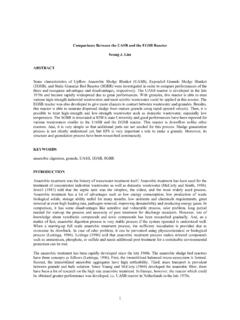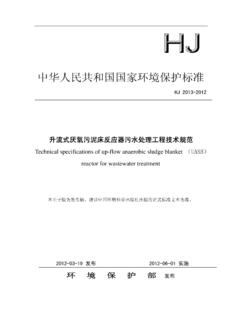Transcription of SEWAGE TREATMENT – TECHNOLOGIES
1 SEWAGE TREATMENT TECHNOLOGIESTECHNOLOGIEST ypes of contaminants in SewageTypes of contaminants in SewageORGANICINORGANIC Sugar MilkSuspendedDissolvedSuspendedDissolved Vegetable matter Food residue Plastic bags Cans Fiber clothes SaltBiological treatmentPrimary treatmentSl. NoContaminantSourceEnvironmental significance1 Suspended solidsDomestic use, industrial wastesCause sludge deposits and anaerobic condition in aquatic environmentImportant Waste Water Contaminantsin aquatic environment2 Biodegradable organicDomestic use , industrial wastesCause biological degradation3 PathogensDomestic waterTransmit communicable disease4nutrientsDomestic and industrial wasteCause eutrophication5 Refractory organicsIndustrial wasteCause taste and odour problemsPollutants in SEWAGE BOD(Bio Chemical Oxygen demand) COD(Chemical Oxygen demand) COD(Chemical Oxygen demand)
2 TSS(Total Suspended Solids) PHBOD(Biochemical Oxygen demand)The BOD is an important measure of water quality .It is measure of the amount of oxygen needed by bacteria and other organisms to oxidize the organic matter present in a water sample over a period of 5 days at 20 degree (Chemical Oxygen Demand) COD Measures all organic carbon with the exception of some aeromatics(BENZENE,TOLUENE,PHENOL etc.) which are not completely oxidized in the reaction. COD is a chemical oxidation reaction Ammonia will not be Suspended Solids Total suspended solids(TSS) include all particles suspended in water which will pass through a filter.
3 As levels of TSS increase, a water body begins to lose its ability to support a diversity of aquatic life. Suspended solids absorb heat from sunlight, which increases water temperature and subsequently decreases levels of dissolved oxygen(warmer water holds less oxygen than cooler water)STANDARDS OF RAW/ TREATED Effluent After secondarytreatmentAfter tertiary treatment1pH value and grease, mg/l max201023 Total residual chlorine, mg/l max nitrogen (as N),mg/l, max505065 Total kjeldahl nitrogen (as N);mg/l, max. mg/l, max 100166 Free ammonia (as NH3), mg/l, max oxygen demand (3 days at 27 C), mg/l, max35030<58 Chemical oxygen demand, mg/l, max 250509 Suspended solids mg/l.
4 Of SEWAGE TREATMENT Plants Pumping of SEWAGE Primary TREATMENT Secondary TREATMENT Tertiary TREATMENT Tertiary TreatmentTypical Flow Diagram of SEWAGE TREATMENT PlantTypical Flow Diagram of SEWAGE TREATMENT PlantFINE SCREENINGGRIT REMOVALGRITRAW SEWAGEINLET CHAMBERRAW SEWAGEPUMPINGCOARSESCREENINGRAW SEWAGE PUMPING STATIONPRIMARY TREATMENTAERATION TANKSECONDARYCLARIFIERTREATED WATERDISINFECTIONCHLORINESLUDGE RECIRCULATIONAIR BLOWERRAW SEWAGE PUMPING STATIONPRIMARY TREATMENTSECONDARY TREATMENTTERTIARY TREATMENTSLUDGE SUMPCENTRIFUGESLUDGESLUDGE DEWATERING SURPLUS SLUDGECENTRATE TO ATPumping StationPumping Station Receiving Chamber Coarse Screening Wet Well (Raw SEWAGE Sump) Pump House Raw SEWAGE PumpsSELECTION OF PUMPS FOR RAW SEWAGE FOR MAIN PUMPING STATION (MPS) I:S.
5 5600-2005 NUMBER OF PUMPS REQUIRED (INCLUDING STANBY)2 No. of DWF2 No. of 1 DWF1 No. of 3 DWF FOR INTERMEDIATE PUMPING STATION (IPS)NUMBER OF PUMPS REQUIRED (INCLUDING STANBY) FOR CAPACITY OF PUMPING STATION UPTO 3 MLDUPTO 3 MLD1 No. of 1 DWF1 No. of 2 DWF1 No. of 3 DWFNUMBER OF PUMPS REQUIRED (INCLUDING STANBY) FOR CAPACITY OF PUMPING STATION ABOVE 3 MLD 2 No. of DWF2 No. of 1 DWF1 No. of 3 DWFVELOCITY CONSIDERATION IN DESIGN OF PUMPING (RISING) MAIN FOR PUMPING SEWAGE The size of Rising main should be designed after taking intoconsideration that:Maximumvelocity at peak flowshould not exceed at lowflows should not be less than 1 Station with submersible pump setPumping Station with submersible pump setPUMP VALVEMANHOLEBYPASSGATERECEIVINGCHAMBERSC REENINGWET WELLHOUSESUBMERSIBLE PUMP CHAMBERP umping Station with Centrifugal Pump setPumping Station with Centrifugal Pump setPUMP HOUSEMANHOLEBYPASSGATERECEIVINGCHAMBERSC REENINGWET WELLHOUSESUBMERSIBLE PUMP CENTRIFUGAL HORIZONTAL PUMPSP rimary TreatmentPrimary TREATMENT Fine Screening Grit Removal Primary Clarification Objective : Removal of coarse solids Types of screens.
6 Fine / medium / coarse Cleaning of screens: Manual / mechanicalScreening Cleaning of screens: Manual / mechanical Benefits: Protection of pumps Coarse Screening: 20mm clear spacing in bars Fine screening: 6mm clear spacing in barsScreeningScreeningARC BAR SCREENGrit Removal Objective: Removal of inorganic solids sand/ Silt to protect moving mechanical equipment Principle: Gravity separation (a) effective size Primary TREATMENT Primary TREATMENT mm (b) specific gravity Types: Manual grit removal - Rectangular channelMechanical grit removal - Circular tank Grit removal Mechanism : Screw classifier / reciprocating classifier MECHANICALLY CLEANED GRIT CHAMBER WITH ORGANIC WASHERGrit RemovalGRIT CHAMBER WITH CLASSIFIER & WASHERS econdary TreatmentSecondary TreatmentBiological treatmentSewage TreatmentMethod of TREATMENT -Aerobic, Anaerobic.
7 Aerobic- SEWAGE TREATMENT in the presence ofOxygen-MBBR,SBR-whereaerators/blowersa reOxygen-MBBR,SBR-whereaerators/blowersa reinstalled-generally no smell during TREATMENT . Anaerobic- SEWAGE TREATMENT in the absence ofOxygen-UASB-No aerators/blowers are required-foulsmell during SEWAGE TREATMENT TECHNOLOGIES Activated Sludge Process (ASP) Upflow Anaerobic Sludge Blanket Reactor (UASB) Moving Bed Biofilm Reactor (MBBR) Moving Bed Biofilm Reactor (MBBR) Sequential Batch Reactor (SBR)AERATIONSEDIMENTATIONSLIDGE RECIRCULATIONTREATED SEWAGEOUTSEWAGEINA ctivated Sludge Process Activated Sludge Process -- ASPASPEXCESS SLIDGE WITHDRAWLSLIDGE RECIRCULATION Raw Effluent In Aeration Sedimentation Treated water out Sludge Recirculation Sludge withdrawlASP ASP -- Flow DiagramFlow DiagramCHLORINESCREENINGGRIT REMOVALGRITPUMPED RAW SEWAGEPRIMARY CLARIFIERRAW SEWAGE INLET CHAMBERPC-AT-SC-CHLAERATION TANKSECONDARYCLARIFIERTREATED WATERDISINFECTIONCHLORINECENTRATE TO ATSLUDGE STABILISATIONSLUDGE THICKNERSLUDGEA ctivated Sludge Process (ASP)
8 Technology An activated sludge plant essentially consists of the following:1) Aeration tank containing micro organisms in suspension in which reaction takes ) Activated sludge recirculation ) Excess sludge wasting and disposal )Aeration systems to transfer oxygen4)Aeration systems to transfer oxygen5) Secondary sedimentation tank to separate and thicken activated Advantages Can sustain seasonal variation Less land requirement than UASB Disadvantages High energy consumption Foaming,particularly in winter season, may adversely Foaming,particularly in winter season, may adversely affect the oxygen transfer, and hence performance Requires elaborate sludge digestion /drying/disposal arrangement More land requirement than SBR & MBBR Nitrogen and Phosphorous removal requires additional anoxic tank and > 3 times internal recirculationASPASPU pflow Anaerobic Sludge Blanket Reactor (UASB)
9 The Up flow Anaerobic Sludge Blanket reactor (UASB) maintains ahigh concentration of biomass through formation of highly settleablemicrobial aggregates. The SEWAGE flows upwards through a layer ofsludge. The sludge in the UASB is tested for pH, volatile fatty acids(VFA),alkalinity, COD and SS. If the pH reduces while VFA increases, thesewageshouldnotbeallowedintotheUASB untilthepHandVFAsewageshouldnotbeallowed intotheUASB untilthepHandVFAstabilise. The reactor may need to be emptied completely once in five years,while any floating material (scum) accumulated inside the gascollector channels may have to be removed every two years toensure free flow of gas.
10 All V-notches must be cleaned in order to maintain the uniformwithdrawal of UASB effluent coming out of each V-notch. Theirregular flow fromeach V-notch results in the escape of more solidswashout. Similarly, blocking of the V-notches of the effluent gutterswill lead to uneven distribution of SEWAGE in the Up Flow Anaerobic Sludge Blanket Rector (UASB) Flow Anaerobic Sludge Blanket Rector (UASB) Flow DiagramFlow DiagramSCREENINGGRIT GRITRAW SEWAGERAW SEWAGE INLET CHAMBERELECTRICITYUASB-AT-SC-CHLAERATION TANK SECONDARYCLARIFIERTREATED WATERDISINFECTIONCHLORINEGRIT REMOVALINLET CHAMBERGAS HOLDERSLUDGE DEWATERINGSYSTEMUASBGAS ENGINEUASBA dvantages Requires less power than aerobic processes Biogas generated can be used as fuel or Disadvantages UASB alone does not treat the SEWAGE to desirable limits.




